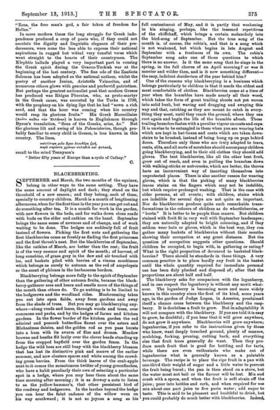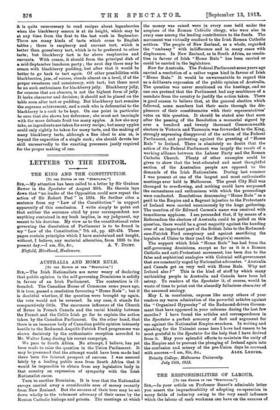BLACKBERRYING.
SEPTEMBER and March, the two months of the equinox, belong in other ways to the same setting. They have the same amount of daylight and dark; they stand on the threshold of a new season; and they belong, each of them, specially to country children. March is a month of lengthening afternoons, when for the first time in the year you can get out and do something after tea. It is a month for work in the garden, with new flowers in the beds, and for walks down clean roads with buds on the elder and catkins on the hazel. September brings the same sense of newness and of change, and of work waiting to be done. The hedges are suddenly full of fruit instead of flowers. Picking the first nuts and gathering the first blackberries come as freshly as finding the first primroses and the first thrush's nest. But the blackberries of September, like the catkins of March, are better than the rest; the fruit is of the very essence and spirit of the month; of harvest, of long sunshine, of grass grey in the dew and air touched with ice, and baskets piled with berries of a vinous muskiness which belongs as surely to autumn as the red of ampelopsis or the scent of phloxes in the herbaceous borders.
Blackberrying belongs more fully to the spirit of September than the gathering of other autumn fruits, because the black- berry-gatherer sees and hears and smells more of the things of the month than others do. To go nutting is to be limited to the hedgerows and the woodland rides. Mushrooming takes you out into open fields, away from gardens and away from the shade of trees. But you may go blackberrying any- where—along roads and lanes, through woods and trees, over commons and parks, and by the hedges of farms and kitchen gardens. In the flower border of the kitchen garden the red admiral and peacock butterflies flaunt over the asters and Michaelmas daisies, and the golden rod as you pass bursts into a hum with its swarm of flies and drones. Meadow browns and heaths flit lazily over the clover heads standing up from the cropped hayfield over the garden fence. In the hedge the wild bees are still busy with the blackberry blossom that has lost its distinctive pink and mauve of the earlier summer, and now clusters sparse and white among the crowd- ing green berries. From the thick leaves of the crab-apple next to it comes the monotonous twitter of young greenfinches, who have a habit peculiarly their own of selecting a particular spot in a hedge, where you may hear them about the same time morning after morning ; it is as drowsy a note to listen to as the yellow-hammer's, that other persistent bird of the roadway and hedgerows. In the larches beyond the hedge you can hear the faint cadence of the willow wren on his way southward ; it is not so joyous a song as his
full contentment of May, and it is partly that weakening in his singing, perhaps, like the lessened repetitions of the chiffchaff, which brings a certain melancholy into the bird-song of September. But the true song of the month is, of course, the robin's, and that is a song which is not weakened, but which begins in late August and September with a freshness of its own. The robin's September song asks one of those questions to which there is no answer. Is it the same song that he sings in the spring, in the full chorus of an April morning ? or was it merrier and wilder then, and is it now something different—. the easy, indolent desiderium of the year behind him ?
One of the reasons why blackberrying is a business which belongs particularly to children is that it needs the oldest and most comfortable of clothes. Blackberries come at a time of year when the brambles have made nearly all their wood, which takes the form of great trailing shoots not yet woven into solid bush, but waving and dragging and swaying this way and that, catching as they are meant to catch in every- thing they meet, until they reach the ground, where they can root again and begin the life of the bramble afresh. These trailing branches fasten with a peculiar vigour on coats and caps. It is unwise to be entangled in them when you are wearing hats which are kept in hat-boxes and coats which are taken down- stairs to be brushed, instead of being hung up on pegs behind doors. Therefore only those who are truly adapted to tears, rents, slits, and all sorts of scratches should accompany children going blackberrying, and to their old clothes they should add gloves. The best blackberries, like all the other best fruit, grow out of reach, and even in pulling the branches down with walking-sticks or nut-crooks, which are better, the thorns have an inconvenient way of inserting themselves into unprotected places. There is also another reason for wearing gloves, which is that the picking of many blackberries leaves stains on the fingers which may not be indelible, but which require prolonged washing. That is the case with older persons, at all events ; with children, stains which are indelible for several days are not quite BO important. Nor do blackberries produce quite such remarkable trans- formations in the colours of children as do whortleberries, or "hurts." It is better to be purple than mauve. But children stained with fruit fit in very well with September landscapes; they are naturally adapted to bright colouring, and if they seldom wear hats or gloves, which is the best way, they can gather many baskets of blackberries without their mouths showing their occupation at any great distance. But the question of occupation suggests other questions. Should children be occupied, to begin with, in gathering or eating? What is the right proportion of devoured to basketed black- berries ? There should be standards in these things. A very common practice is to place hardly any fruit in the basket until the whole quantity required for immediate personal use has been duly plucked and disposed of; after that the proportions are about half and half.
The blackberry asks for comparison with the loganberry, and in one respect the loganberry is without any merit what- ever. The loganberry is becoming more and more widely known in this country since the first of its kind, some years ago, in the garden of Judge Logan, in America, proclaimed itself a chance cross between the blackberry and the rasp- berry. It is doubtless a fruit to grow. But in adaptability it will not compare with the blackberry. If you are told it is easy to grow, be doubtful ; if you hear that it will grow anywhere, do not grow it anywhere. Blackberries will grow anywhere; loganberries, if you refer to the instructions given by those who know, want deeply trenched ground, plenty of manure, mulching, forking, pruning, cutting back, and everything else that fruit trees generally do want. Then they pro- duce much fruit that is good for bottling and for tarts, while there are even enthusiasts who make out of loganberries what is generally known as a palatable beverage. The recipe is to place the ripe fruit in a pan with one-third their weight of sugar and a little water to prevent the fruit being burnt ; the pan is then stood on a stove, but the water must not boil or the flavour will be lost. Mix and crush with a spoon, and when the fruit is soft strain off the juice ; pour into bottles and cork, and when required for use mix about one part juice to five parts water ; add sugar to taste. This is said to be pleasant and healthful to drink, but you could probably do much better with blackberries. Indeed, it is quite unnecessary to read recipes about loganberries when the blackberry season is at its height, which may be at any time from the first to the last week in September. There are many kinds of tarts which come to English tables ; there is raspberry and currant tart, which is better than gooseberry tart, which is to be preferred to other tarts; but blackberry tart is far above raspberries and currants. With cream, it should form the principal dish of a mid-September luncheon party ; the next day there may be cream with blackberry pudding, but after that it would be better to go back to tart again. Of other possibilities with blackberries, jam, of course, stands almost on a level, if of the proper sweetness and consistency, with tart; but there must be no such enthusiasm for blackberry jelly. Blackberry jelly, for reasons that are obscure, is not the highest form of jelly. It lacks character and decision; it should not be placed on the table soon after tart or pudding. But blackberry tart remains the supreme achievement, and a cook who is deferential to the blackberry is a cook to be kept. On one point in particular be sure that she shows her deference; she must not immingle with the more delicate fruit too many apples. A few she may take, as ingredients are taken for every recipe; but many apples could only rightly be taken for many tarts, and the making of many blackberry tarts, although a fine ideal to aim at, is beyond the capacities of a single cook ; she should devote her skill unreservedly to the exacting processes justly required for the proper making of one.











































 Previous page
Previous page